Brazil Insulin Drugs & Delivery Devices Market Size
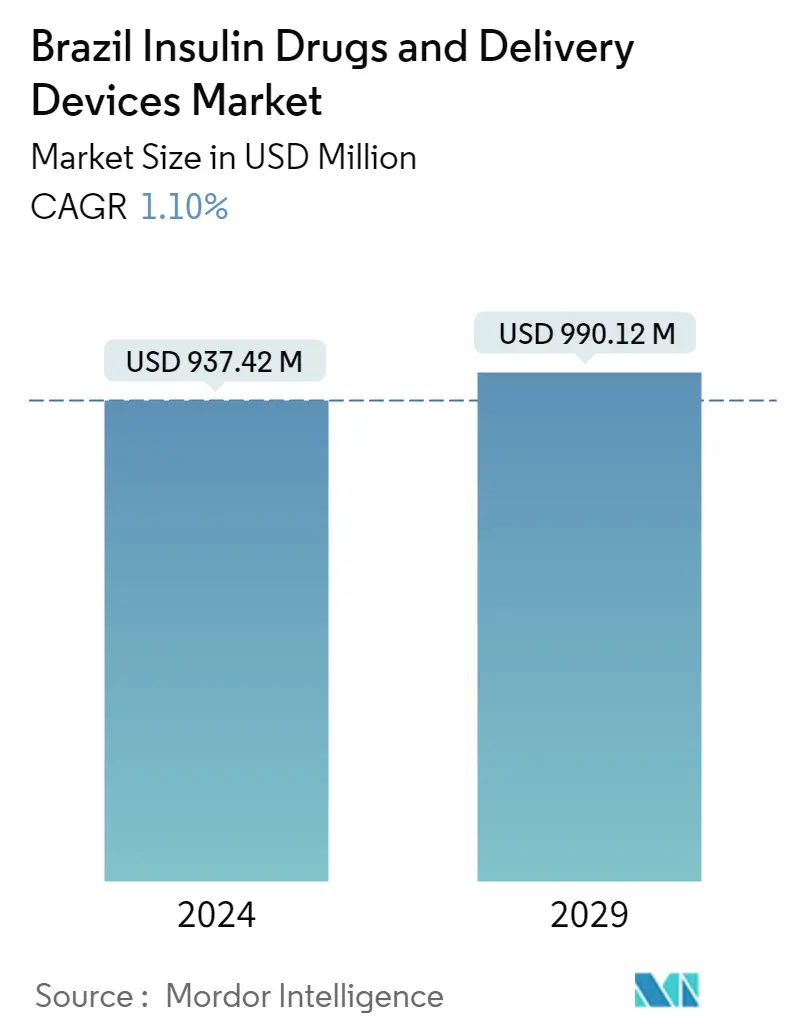
| Study Period | 2018 - 2029 |
| Base Year For Estimation | 2023 |
| Forecast Data Period | 2024 - 2029 |
| Market Size (2024) | USD 937.42 Million |
| Market Size (2029) | USD 990.12 Million |
| CAGR (2024 - 2029) | 1.10 % |
Major Players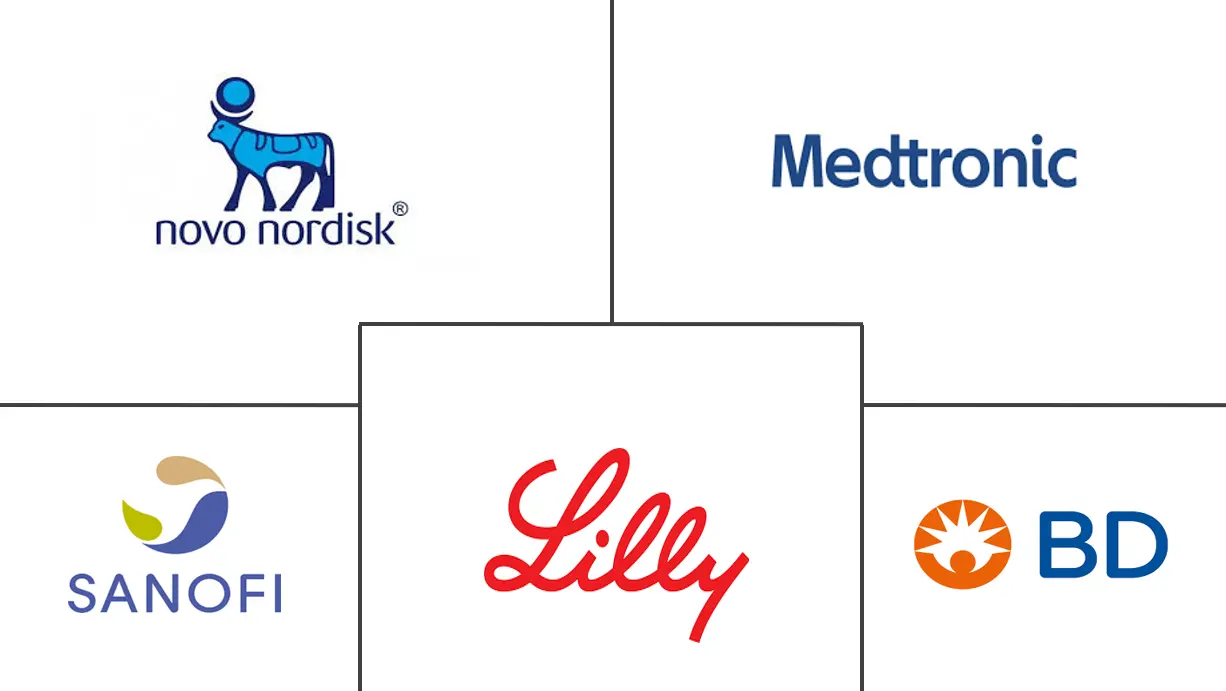
*Disclaimer: Major Players sorted in no particular order |
Need a report that reflects how COVID-19 has impacted this market and its growth?
Brazil Insulin Drugs & Delivery Devices Market Analysis
The Brazil Insulin Drugs & Delivery Devices Market size is estimated at USD 937.42 million in 2024, and is expected to reach USD 990.12 million by 2029, growing at a CAGR of 1.10% during the forecast period (2024-2029).
Diabetes is a chronic condition demanding self-management and care, which involves regular attention to food, physical activity, blood sugar monitoring, and the use of medications. People with chronic diseases such as diabetes mellitus and obesity have a worse prognosis of COVID-19. Diabetic people are twice as likely to have their comorbid conditions worsened and consequently die. The healthcare system must be better organized for more severe cases of COVID-19 as studies suggest that inadequate glycemic control increases the risk of undesired outcomes in diabetic patients with SARS-CoV-2 infection. The prevalence of diabetes in people hospitalized with COVID-19 infection and the recognition that improved glycemic control might improve outcomes and reduce the length of stay in patients with COVID-19 have underlined the importance of diabetes care.
Diabetes is associated with many health complications. Comparing the population with and without diabetes, those with diabetes have a 300% increased risk of being hospitalized and, thus, incur more healthcare expenses compared to non-diabetic people. People with diabetes face a higher chance of experiencing serious complications from COVID-19. In general, people with diabetes are more likely to experience severe symptoms and complications when infected with a virus. Diabetes and high glucose levels are associated with increased complications, respiratory failure, and mortality in hospitalized patients with coronavirus.
Brazil has implemented a set of reforms over the past to improve the distribution of doctors, develop new forms of the service organization, introduce new financing models, and implement a range of quality improvement initiatives and policy frameworks to overcome risk factors such as obesity and emerging pandemic threats. The pandemic also highlighted opportunities for continuing and expanding innovations in the delivery of diabetes care, through virtual consultations between healthcare providers and people with diabetes, and the use of diabetes technology. Thus, the COVID-19 outbreak increased the insulin market's growth.
Brazil Insulin Drugs & Delivery Devices Market Trends
Rising diabetes prevalence
The diabetes population in Brazil is expected to grow by about 2.9% over the forecast period.
According to IDF Diabetes Atlas 2021, 15.7 million adults, about 10.5%, had diabetes in Brazil. The cost of diabetes-related health expenditure in Brazil is the third highest in the world. In addition, 18 million adults, around 11.9%, includes Impaired Glucose Tolerance, which places them at high risk of developing type 2 diabetes. 32% of people living with diabetes in Brazil are undiagnosed. Additional data on glycemic control in Brazil show that only 25% met the therapeutic goal of glycated haemoglobin (HbA1c) < 7% before the pandemic, as recommended by the Brazilian Diabetes Society (SBD).
In Brazil, the public health system (Sistema Único de Saúde; SUS) progressively increased the assistance available for individuals with diabetes. The Ministry of Health established a list of medications and supplies the Brazilian Health System (SUS) provided to patients suffering from diabetes. However, their supply is usually insufficient or recommended for optimal patient management across cities. The high prevalence of diabetes is associated with a significant economic burden.
When diabetes is undetected or inadequately treated, people with diabetes are at risk of serious and life-threatening complications, such as heart attack, stroke, kidney failure, blindness, and lower-limb amputation. These result in reduced quality of life and higher healthcare costs, leading to a greater need for access to care. Various evidence suggests that diabetes can be successfully managed, especially when detected early. Multifactorial intervention, including control of blood glucose, blood pressure, and lipids, can reduce the range of diabetes-related microvascular and macrovascular complications and premature mortality.
Therefore, owing to the increasing diabetes prevalence, the studied market is anticipated to grow over the analysis period.
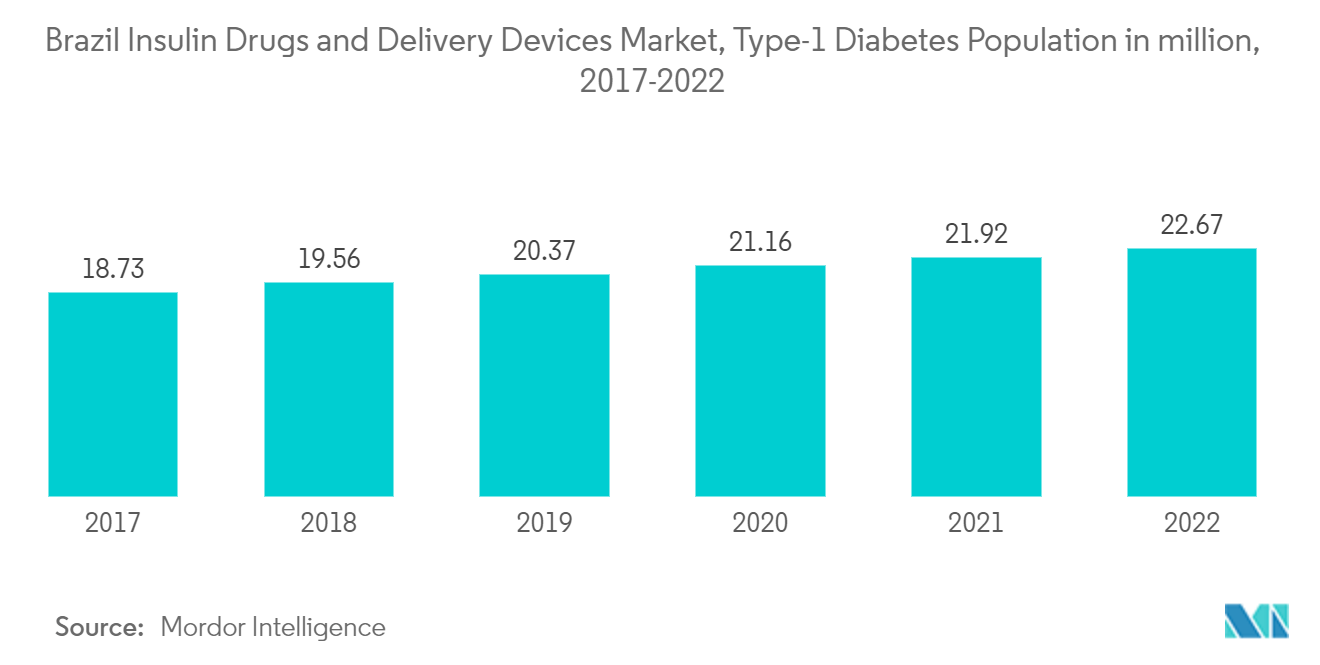
Insulin disposable pens hold the highest market share in the insulin delivery devices segment in the current year
Insulin Disposable Pens occupied the highest market share of about 58% in the insulin delivery devices segment in the current year.
A disposable insulin pen contains a prefilled amount of insulin. When the pen is empty, it is thrown away. Insulin pens are much smaller, more portable than syringes, and contain the medicine preloaded into the delivery mechanism. The needles are easy to use and can be disposed of by twisting or snapping. The pens are usually colour-coded, making it easier to know which type of insulin and how much it will be received from them. The disposable insulin pens are considered more consumer-friendly, as they are smaller and less noticeable than the classic vial-and-syringe. These devices are also more portable for consumers. Some pens are smart insulin pens that easily connect to an app on the phone to monitor blood sugar levels and remind when to take the next insulin dose.
The high prevalence of diabetes is associated with a significant economic burden. The costs of diabetes are increased in patients with co-morbidities such as hypertension and hyperlipidemia and who develop complications. Costs increase with an increasing number of complications. The Federal Government of Brazil partnered with numerous private companies to primarily utilize their supply chain (manufacturing, distribution, and retailers) to ensure low device prices. Such factors helped the increased adoption of these products in the Brazilian market.
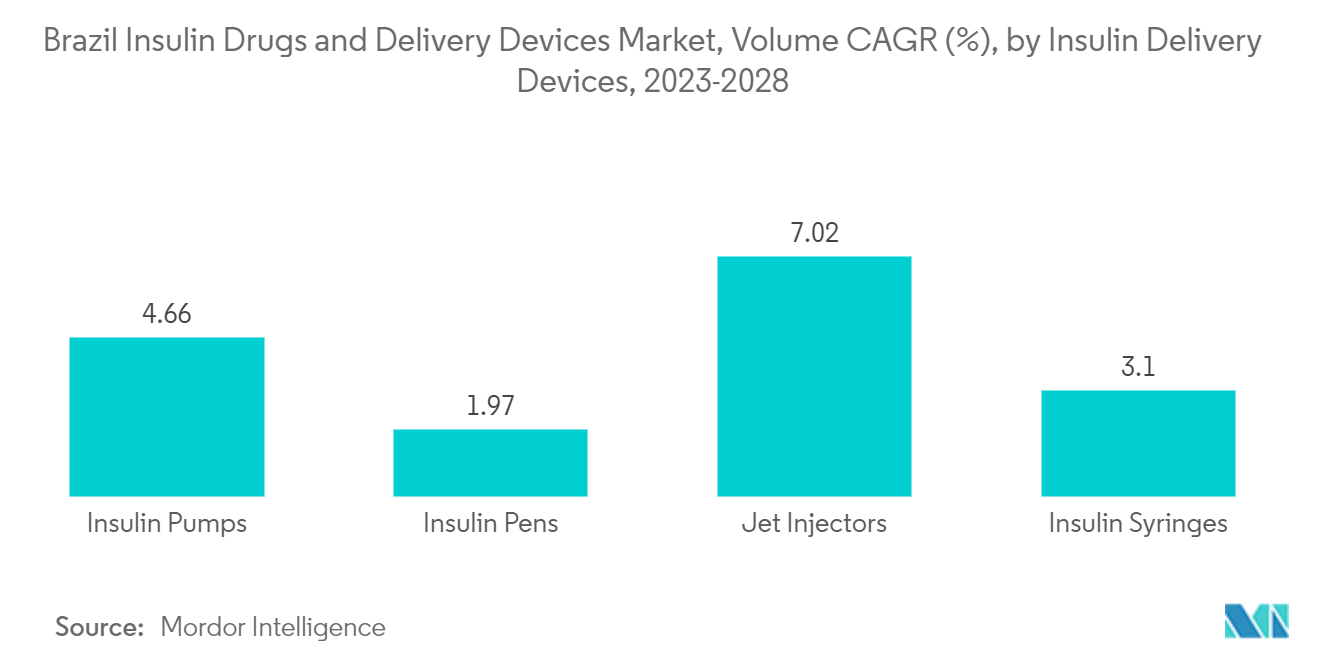
Brazil Insulin Drugs & Delivery Devices Industry Overview
The Brazil Insulin Drugs and Delivery Devices Market is moderately consolidated, with few significant and generic players. Mergers and acquisitions between the players recently helped the companies strengthen their market presence. Eli Lilly and Boehringer Ingelheim allied in developing and commercializing Basaglar (Insulin Glargine). Additionally, the players in the recent past helped the companies strengthen their market presence. For example, Novo Nordisk collaborated with Ypsomed to provide better insulin therapy solutions.
Brazil Insulin Drugs & Delivery Devices Market Leaders
Novo Nordisk
Eli Lilly
Sanofi
Medtronic
Becton Dickinson
*Disclaimer: Major Players sorted in no particular order
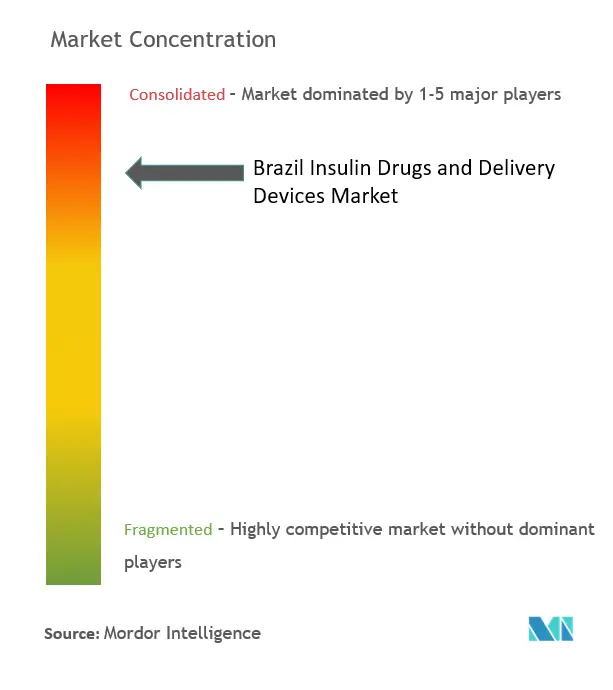
Brazil Insulin Drugs & Delivery Devices Market News
- January 2023: Lannett Company provided an update on the clinical advancement and development of its biosimilar insulin aspart and biosimilar insulin glargine products. Lannett is developing both products with its strategic alliance partner, the HEC Group of Companies (HEC).
- March 2022: Oramed announced ORMD-0801 (a new molecule) is being evaluated in two pivotal Phase 3 trials and can be the first oral insulin capsule with the most convenient and safest way to deliver insulin therapy. This drug is expected to be a game-changer in the insulin and oral anti-diabetes drugs markets.
Brazil Insulin Drugs & Delivery Devices Market Report - Table of Contents
1. INTRODUCTION
1.1 Study Assumptions and Market Definition
1.2 Scope of the Study
2. RESEARCH METHODOLOGY
3. EXECUTIVE SUMMARY
4. MARKET DYNAMICS
4.1 Market Overview
4.2 Market Drivers
4.3 Market Restraints
4.4 Porter's Five Forces Analysis
4.4.1 Bargaining Power of Suppliers
4.4.2 Bargaining Power of Consumers
4.4.3 Threat of New Entrants
4.4.4 Threat of Substitute Products and Services
4.4.5 Intensity of Competitive Rivalry
5. MARKET SEGMENTATION
5.1 Drug
5.1.1 Basal or Long-acting Insulins
5.1.1.1 Lantus (Insulin Glargine)
5.1.1.2 Levemir (Insulin Detemir)
5.1.1.3 Toujeo (Insulin Glargine)
5.1.1.4 Tresiba (Insulin Degludec)
5.1.1.5 Basaglar (Insulin Glargine)
5.1.2 Bolus or Fast-acting Insulins
5.1.2.1 NovoRapid/Novolog (Insulin aspart)
5.1.2.2 Humalog (Insulin lispro)
5.1.2.3 Apidra (Insulin glulisine)
5.1.2.4 FIASP (Insulin aspart)
5.1.2.5 Admelog (Insulin lispro Sanofi)
5.1.3 Traditional Human Insulins
5.1.3.1 Novolin/Mixtard/Actrapid/Insulatard
5.1.3.2 Humulin
5.1.3.3 Insuman
5.1.4 Combination Insulins
5.1.4.1 NovoMix (Biphasic Insulin aspart)
5.1.4.2 Ryzodeg (Insulin degludec and Insulin aspart)
5.1.4.3 Xultophy (Insulin degludec and Liraglutide)
5.1.4.4 Soliqua/Suliqua (Insulin glargine and Lixisenatide)
5.1.5 Biosimilar Insulins
5.1.5.1 Insulin Glargine Biosimilars
5.1.5.2 Human Insulin Biosimilars
5.2 Device
5.2.1 Insulin Pens
5.2.1.1 Cartridges in reusable pens
5.2.1.2 Disposable insulin pens
5.2.2 Insulin Pumps
5.2.2.1 Insulin Pump Devices
5.2.2.2 Insulin Pump Reservoirs
5.2.2.3 Insulin Infusion sets
5.2.3 Insulin Syringes
5.2.4 Insulin Jet Injectors
6. MARKET INDICATORS
6.1 Type-1 Diabetes Population
6.2 Type-2 Diabetes Population
7. COMPETITIVE LANDSCAPE
7.1 COMPANY PROFILES
7.1.1 Novo Nordisk
7.1.2 Sanofi
7.1.3 Eli Lilly
7.1.4 Biocon
7.1.5 Julphar
7.1.6 Medtronic
7.1.7 Ypsomed
7.1.8 Becton Dickinson
- *List Not Exhaustive
7.2 COMPANY SHARE ANALYSIS
7.2.1 Insulin Drugs
7.2.1.1 Novo Nordisk
7.2.1.2 Sanofi
7.2.1.3 Eli Lilly
7.2.1.4 Others
7.2.2 Insulin Delivery Devices
7.2.2.1 Medtronic
7.2.2.2 Ypsomed
7.2.2.3 Becton Dickinson
7.2.2.4 Others
8. MARKET OPPORTUNITIES AND FUTURE TRENDS
Brazil Insulin Drugs & Delivery Devices Industry Segmentation
Insulin is mainly used to treat type 1 diabetes but can be used in people with type 2 diabetes if insulin levels remain low despite using other medications. There are different ways to inject insulin into a patient's body, using syringes, pens, pumps, and jet injectors, giving them various options for insulin delivery. The Brazil Insulin Drugs and Delivery Devices Market is segmented into Drugs (Basal or Long-acting insulins, Bolus or Fast-acting insulins, traditional human insulins, combination insulins, and biosimilar insulins) and devices (insulin pens, insulin pumps, insulin syringes, and jet injectors). The report offers the value (in USD million) and volume (in a million mL) for insulin drugs and (in unit million) for the devices for the above segments.
| Drug | |||||||
| |||||||
| |||||||
| |||||||
| |||||||
|
| Device | |||||
| |||||
| |||||
| Insulin Syringes | |||||
| Insulin Jet Injectors |
Brazil Insulin Drugs & Delivery Devices Market Research FAQs
How big is the Brazil Insulin Drugs & Delivery Devices Market?
The Brazil Insulin Drugs & Delivery Devices Market size is expected to reach USD 937.42 million in 2024 and grow at a CAGR of 1.10% to reach USD 990.12 million by 2029.
What is the current Brazil Insulin Drugs & Delivery Devices Market size?
In 2024, the Brazil Insulin Drugs & Delivery Devices Market size is expected to reach USD 937.42 million.
Who are the key players in Brazil Insulin Drugs & Delivery Devices Market?
Novo Nordisk, Eli Lilly, Sanofi, Medtronic and Becton Dickinson are the major companies operating in the Brazil Insulin Drugs & Delivery Devices Market.
What years does this Brazil Insulin Drugs & Delivery Devices Market cover, and what was the market size in 2023?
In 2023, the Brazil Insulin Drugs & Delivery Devices Market size was estimated at USD 927.22 million. The report covers the Brazil Insulin Drugs & Delivery Devices Market historical market size for years: 2018, 2019, 2020, 2021, 2022 and 2023. The report also forecasts the Brazil Insulin Drugs & Delivery Devices Market size for years: 2024, 2025, 2026, 2027, 2028 and 2029.
Brazil Insulin Drugs & Delivery Devices Industry Report
Statistics for the 2024 Brazil Insulin Drugs & Delivery Devices market share, size and revenue growth rate, created by Mordor Intelligence™ Industry Reports. Brazil Insulin Drugs & Delivery Devices analysis includes a market forecast outlook 2029 and historical overview. Get a sample of this industry analysis as a free report PDF download.
